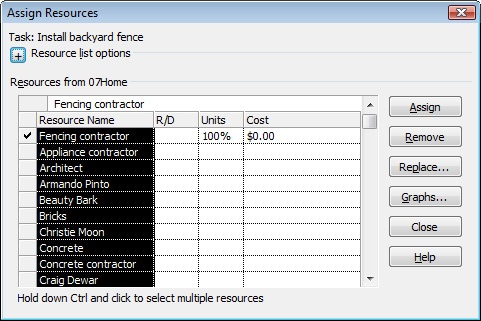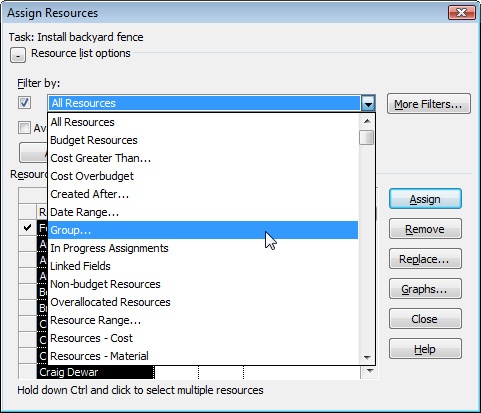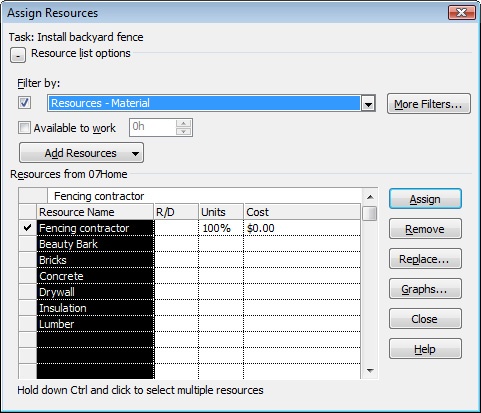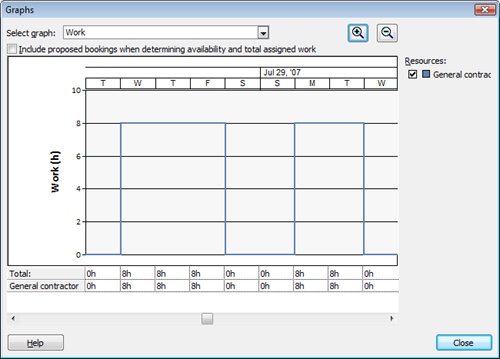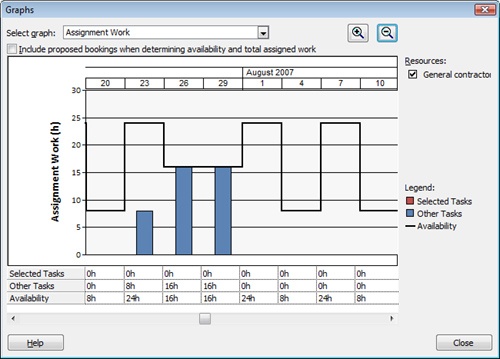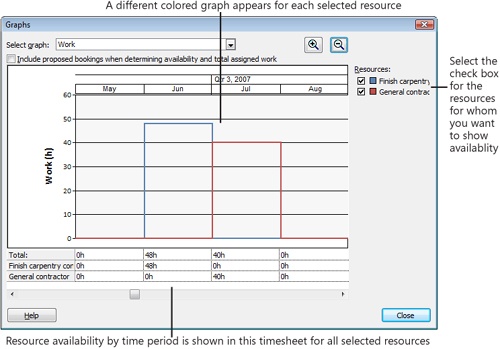You have tasks. You have resources. Now you need to get them together. Tasks + resources = assignments. With human and equipment resources assigned to tasks, Microsoft Office Project 2007 can create a project schedule that reflects not only the project calendar, task durations, dependencies, and constraints, but also the calendars and availability of assigned resources. With material and cost resources assigned to tasks, you can track the depletion of project-related inventory as well as specific cost items to ensure you have what you need to accomplish tasks when you need them.
When you assign a work resource, you are attaching the resource name to a task and then indicating how much of the resource’s total availability is to be devoted to this task.
When you first add a resource to the project plan, through the use of maximum units (you might also think of them as resource units), you specify how available this resource will be to this project. For example, if the resource is available full time on the project, say, 40 hours a week, you would probably specify that the resource has 100%maximum units. If another resource is available 20 hours a week, you would probably specify that this resource has 50% maximum units. If you have three of the same type of resource (for example, three graphic designers), you could indicate that there are 300% maximum units.
When you assign these resources to tasks, you take the idea of availability a step further by using assignment units. With maximum units, you specify resource availability to the project as a whole. With assignment units, you specify resource allocation to the specific task to which the resource is assigned.
For example, one resource might be available full time to perform one task. When that’s finished, she’ll be assigned full time to the next task, and so on. Upon assigning this resource to the task, you indicate 100% assignment units for this resource.
You might have another full-time resource, however, who is spending 40 percent of his time on one task and 60 percent of his time on another task that takes place at the same time. For the first task, you specify 40% assignment units; and for the second task, 60%. The assignment units specify the percentage of the full 100% maximum units being used for the task in question.
Now, take the case of a half-time resource (50% maximum units) who is spending all available time on one task. The maximum assignment units you can have for this resource are 50%. If this resource is spending half her time on one task and half on another, the assignment units are 25% for each task.
Note
If this resource is assigned to other tasks at the same time, Office Project 2007 allows it, but flags the resource and the assignment as overallocated, that is, having more work than there is time, or availability, to do the tasks.
Finally, let’s look at the case of the three graphic artists whose max units are 300%. When you start to assign tasks to a consolidated resource such as this one, Project 2007 does not assume that you want to use all three on one task. You can, but the default assignment units are 100%. You can change those units to any increment up to 300%.
Note
By default, assignment units are expressed as a percentage, but you can express them as a decimal if you prefer. Click Tools, Options and then click the Schedule tab. In the Show Assignment Units As A box, click Decimal. A resource working full time on an assignment is shown as having 1 assignment unit instead of 100%. This setting also changes how maximum units are displayed in the Resource Sheet.
By creating an assignment, you specify both the resources assigned to a task as well as their associated assignment units. Using the Assign Resources dialog box, you can assign one resource to a task, multiple resources to a task, or multiple resources to multiple tasks. To assign a work resource to a task, follow these steps:
In the Gantt Chart or other task sheet, click the task to which you want to assign resources.
On the Standard toolbar, click Assign Resources.
The Assign Resources dialog box appears (see Figure 7-1).
In the dialog box, click the name of the work resource you want to assign to the task and then click the Assign button.
The resource name moves to the top of the Resources list in the table, and a default percentage appears in the Units field for the resource. For individual resources, the default assignment units are the same as the resource’s maximum units. For consolidated resources with more than 100% maximum units, the default assignment units are 100%.
If you want to assign a second resource, click that resource name and then click the Assign button.
Modify the Units field for any assigned resources as necessary. If you change the Units field, you need to press Enter or click another field. Pressing Enter ends the edit mode for the field, sets your change, and makes the Assign button available.
Repeat steps 4 and 5 for all resources you want to assign to the selected task.
To assign resources to a different task, click the next task for which you want to make assignments.
You don’t have to close the Assign Resources dialog box to select a different task.
Repeat steps 3–6 to assign resources to all tasks as necessary.
When finished assigning resources to tasks, click the Close button.
Suppose that you want to assign a specific resource to a task, but that resource isn’t listed in the Assign Resources dialog box because you haven’t added him or her to your Resource Sheet yet. You can add new resources to your project plan while working in the Assign Resources dialog box and then immediately assign the newly added resource to tasks. You can then go to the Resource Sheet and complete any detailed resource information you want. To add new resources in the Assign Resources dialog box, follow these steps:
In the Gantt Chart or other task sheet, click the task to which you want to assign resources.
On the Standard toolbar, click Assign Resources to display the Assign Resources dialog box.
In the Resources table, type the resource name in the next available blank Resource Name field and then press Tab to enter the name and stay in the same field.
Click the Assign button.
The resource name moves to the top of the Resources list in the table, and 100% appears in the Units field for the resource.
Adjust the assignment units if necessary. Assign any additional tasks you want.
When finished, click the Close button.
Click View, Resource Sheet.
The new resource you added in the Assign Resources dialog box is listed. Modify any resource fields as necessary; for example, Group, Max. Units, Calendar.
Note
Double-click any resource name in the Assign Resources dialog box, and the Resource Information dialog box appears for that resource. Enter detailed resource information as you wish.
You can add an entire group of resources from your e-mail address book, Microsoft Office Project Server 2007, or your Windows Server Active Directory to the Assign Resources dialog box, just as you can in the Resource Sheet. To add resources from a server, follow these steps:
With the Gantt Chart or other task sheet open, click Assign Resources on the Standard toolbar.
If necessary, click the + Resource List Options button to expand the dialog box (see Figure 7-2).
Click From Active Directory if you are working with Microsoft Windows Server and want to add resources from the Active Directory directory service.
Click From Address Book if you want to add resources from your e-mail program’s address book.
Click From Microsoft Project Server if you want to add the resources who are listed as Office Project Server 2007 users.
Click the resources you want from the source you chose and then click the Add button to add the selected resources to the Assign Resources dialog box.
After the resources are added, you can immediately assign them to tasks.
You can use the Assign Resources dialog box to narrow your list of resources to only those who meet the criteria needed for the tasks you’re assigning. For example, you can filter the resource list to show only those resources who belong to the marketing department, or only those resources who have a particular job code or skills definition. Using resource fields such as Group or Code comes in handy in these scenarios.
If you create and apply resource outline codes, you can also filter for a particular outline code level.
To find resources that meet certain criteria, follow these steps:
With the Gantt Chart or other task sheet open, click Assign Resources on the Standard toolbar.
If necessary, click the + Resource List Options button. The Assign Resources dialog box expands to show the Filter By box.
Select the check box immediately under Filter By.
Click the arrow in the All Resources box. Scroll to and click the filter that applies to the type of resource you want to find, for example, Group or Resources – Work (see Figure 7-3).
Figure 7-3. Select the check box under Filter By and then click the name of filter that describes the type of resource you’re seeking.
Any filter that requires additional information includes an ellipsis (...) after its name. Click the filter, enter the requested information in the dialog box that appears, and click OK.
As soon as you select a filter, the list in the Resources table changes to show only those resources that meet the filter’s criteria (see Figure 7-4).
When you want to review the full list of resources again, click All Resources in the Filter By list, or simply clear the Filter By check box.
Note
For more information about working with fields, see the section titled Customizing Fields in Chapter 25. For more information about outline codes, see the section titled Working with Outline Codes in Chapter 25.
You can filter your resources to see only those who actually have time to take on more work. For example, suppose that you assigned all your resources to tasks. Then you add several more tasks, and you want to assign only resources who have time for them. To filter for resources with a certain amount of available time, do the following:
With the Gantt Chart or other task sheet open, select the task to which you want to assign resources with available time.
Click Assign Resources on the Standard toolbar.
If necessary, click the + Resource List Options button. The Assign Resources dialog box expands.
Select the Available To Work check box.
In the Available To Work box, enter the amount of time needed for the task you’re about to assign. For example, if you need a resource with 4 days of available time, enter 4d in the box.
As soon as you enter the amount of time, the list in the Resources table changes to show only those resources who have the specified availability.
Assign resources to the selected task as usual.
If you click another task, the filter is applied to that task as well. The list of resources available to work for the specified amount of time might change, depending on the task dates and the resource availability during those dates.
When you want to see the full list of resources again, simply clear the Available To Work check box.
Note
You can find resources in the category you want who have the right amount of available time for your assignments. Under Resource List Options in the Assign Resources dialog box, select both check boxes under Filter By. First, select the resource filter you want to use in the first box and then enter the amount of time in the Available To Work box.
You can review graphs of resource availability from within the Assign Resources dialog box. This can help you decide which work resource should be assigned to a task. To review the resource availability graph, follow these steps:
With the Gantt Chart or other task sheet open, click Assign Resources on the Standard toolbar.
In the Assign Resources dialog box, click the work resource whose availability graph you want to view. Note that availability only applies to work resources—not material or cost resources.
Click the Graphs button. The Resource Availability Graph for the selected resource appears (see Figure 7-5). By default, the work graph is displayed.
To change the field on which the graph is based, click Remaining Availability or Assignment Work in the Select Graph list.
The Work graph shows the total work for all the selected resource’s assignments. The Assignment Work graph breaks down the work on the currently selected tasks in relation to the selected resource’s total work assigned (see Figure 7-6). The Remaining Availability graph shows when the selected resource has any available time for more assignments.
To change the timescale for the graph, click the Zoom In or Zoom Out buttons.
The Zoom In button provides a closer look at a shorter time period. For example, it can change the graph from a view of weeks to a view of days. The Zoom Out button provides an overview of availability over a longer time period. For example, it can change the graph from a view of weeks to a view of months.
When finished reviewing the graph, click the Close button.
The Assign Resources dialog box appears again.
Work is the amount of effort it takes to complete a task. As soon as you assign a resource to a task, the duration is translated into work. A simple example: If you have a task with a 3-day duration, and you assign a single full-time resource to it, that resource now has an assignment with 24 hours of work spread across three days (assuming default calendar settings).
You can see this principle in action by adding the Work field to the Gantt Chart or other task sheet, as follows:
Display the Gantt Chart or other task sheet that contains the Duration field.
Click the heading of the column to the right of the Duration field. For example, if you are working with the default Gantt Chart with the default Entry table applied, click the Start column heading.
Click Insert, Column.
In the Field Name box, click Work. To move quickly to the fields that begin with W, type W.
Click OK.
The Work field appears next to the Duration field, and you can see comparisons between the two (see Figure 7-8).
That task with a 3-day duration and a single full-time resource assigned translates (by default) to 24 hours of work. Another task with a 3-day duration and two full-time resources assigned translates to 48 hours of work. Another task with a 3-day duration and three full-time resource assigned translates to 72 hours of work.
Duration is the length of time it takes from the start to the finish of the task, but work equates to person-hours for the resources assigned.
These calculations are based on the initial assignment; that is, assigning one, two, or six resources at one time to a task that previously had no assigned resources. That is, if you assign two full-time resources to that same 3-day task, both resources are assigned 24 hours of work, also spread across 3 days (see Figure 7-9). When you assign multiple resources initially, Microsoft Project assumes that you intend for the resources to have the same amount of work across the original task duration.
Figure 7-9. In the first task with a single resource assigned, the total work is 24 hours. In the second task with two resources assigned, the total work is 48 hours.
Note
Instead of entering duration and having Microsoft Project calculate work amounts upon assigning tasks, you can do this the other way around. You can enter tasks, assign resources, and then enter work amounts from estimates those resources provide. From those work amounts, Microsoft Project can calculate duration.
Just as work is calculated from the duration and assigned resource availability, duration can be calculated from work amounts and assigned resource availability.
Note
If you don’t specify a work unit, by default Microsoft Project assumes the unit to be hours and automatically enters hrs after your work amount. You can change the default work unit if you like. Click Tools, Options and then click the Schedule tab. In the Work Is Entered In box, select the time unit you want as the default for this project.

